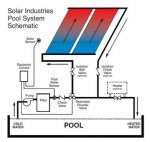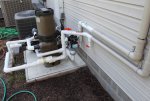Finally, after all that, I personally don't think optimum flow is a big deal even with solar panels. More important is pressure.
Respectfully, I don't agree, but I have no science to back that up, other than manufacturers' recommend flow rates. Since I've seen similar recommendations across multiple brands, I'd like to think they've each done their own independent testing and have determined their own best rates for their own products, which happen to corroborate each other. That could certainly be a naive assumption, but I'm assuming that none the less.
I don't believe the amount of flow through a panel is like salt to an SWG. It's not "once you get enough flow, you get all the heat you're going to get." I believe the heat exchange efficiency is on a curve, and that it relates and tracks directly with flow. So there is an optimum point that one should shoot for, if one is shooting for the warmest pool at the lowest cost.
What I don't know for sure is once you pass the optimum point, if you actually lose heat exchange efficiency (because the water is in the panel for too short a time), or if you're just wasting pump energy and losing cost efficiency because of it. I suspect it's both.
That's not to say pressure is to be ignored. Too much pressure could certainly shorten a panel's lifespan, and potentially cause a premature failure. But I'm virtually certain that if you satisfy a panel's optimum flow rate, it'll be at a pressure that is safe for the panel, so pressure is the
less important concern. They're designed to handle the pressure of the optimum flow rate. So I'm sticking by my installation and setup technique. I used a FlowVis to establish the manufacturer's suggest flow rate, and continue to use it to monitor and adjust flow rate as things change (filter pressure, for one). I think I'm getting better heat exchange because of that, which means my system reaches my heat set point sooner than it would otherwise, and so I have to run my pump less. Eventually the FlowVis will pay for itself, if it hasn't already...
And, for me, the combination of the Vis and the VS pump is ideal. When I catch my panels' flow off by even 1 GPM, I just go into my automation and tweak the pump's RPM a bit to bring the flow back to spec. It's really easy to run. I'm not fooling with valve cams or sticky ball valves, just a push of a software button.





